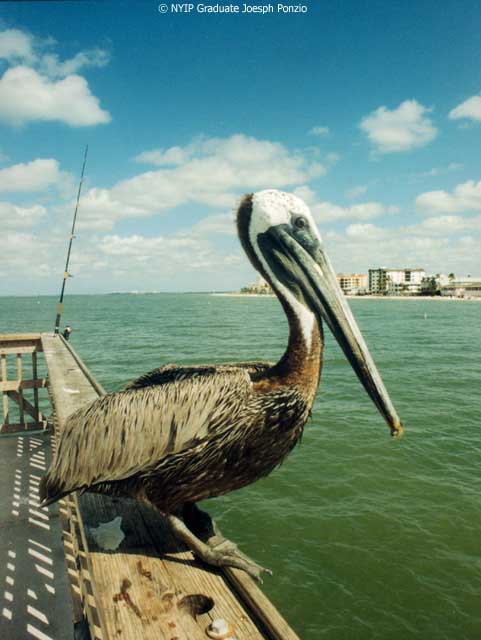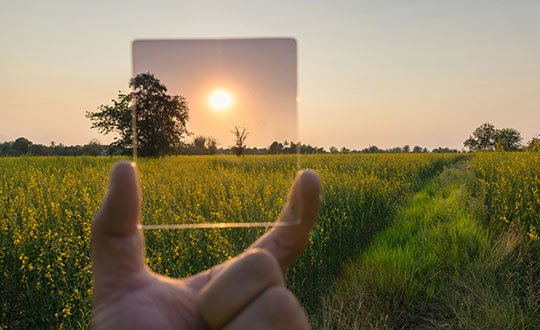Photo by NYIP Digital Photography School graduate Joseph Ponzio

Now that the dreariness of a bleak winter is past, we who do not dwell in southern climes think less about sunny Florida than we did in January. And I suppose that's good in a way with the 'flu season largely gone and the snow in the driveway almost non-existent.
So, when I came across this photograph made by NYIP Graduate Joseph Ponzio, I was immediately conveyed back to Florida and my salad days in South Florida. Mr. Ponzio has shown us this splendid pelican on a pier which I am presuming is in Cape Coral, the photographer's home.
I spoke about my salad days (hold the mayo, please). I used to winter in Hollywood (Fl, not CA) and in Miami Beach on the eastern Gold Coast. I've never been to Cape Coral or anywhere on the western Gulf Coast, but most of coastal Florida is pretty much the same. Both coasts, of course, have a plethora of pelicans. This particular pelican reminds me of my Cousin Herbert on one of his better days (of which there are very few). But, then, the less said about Cousin Herbert the better, I think.
It is hard to describe a pelican as a beautiful bird. I suppose that a professional or amateur ornithologist might wax ecstatically over the pelican's looks, but to me this species is not your pretty little cardinal, blue jay, or goldfinch tweet tweet tweeting in the garden. The pelican seems to me like something out of Jurassic Park — a lineal descendant of an old time pterodactyl. Oh, well, try as we might we can't all look like Paul Newman.
Tomfoolery aside, let's look at the actual photograph. Although I have frequently referred to the three NYIP Guidelines in past Picture of the Month analyses, I'll mention the Guidelines again for the benefit of any new readers: strong subject matter, focusing of attention on the subject, and then simplifying the picture by eliminating the unnecessary and keeping all that is needed.
Strong subject matter? The sheer ugliness of the creature (beauty being solely in the eye of the beholder) is compelling. What about the Hunchback of Notre Dame, Quasimodo? Or the witch in Hansel and Gretel? Or the dashing good looks of Edward G. Robinson in the movies? Point is that ugliness repels us at first but may in the long run attract. In other words, we can't take our eyes off the creature!
And how did Joseph Ponzio focus attention on his subject? Numerous techniques were used.
He placed the pelican very much up front in the foreground, well off center, and standing in comparison to distant objects in the background, thus clearly illustrating the so called Rule of Thirds. The photographer threw the distant background way out of focus in order to emphasize the bird even more. Incidentally, the prehistoric aspect of the pelican stands in stark contrast to the modern high rise buildings in the background. The leading or converging lines of the pier focus attention on the bird. The fishing pole serves a purpose, too, in the composition; the pole helps to frame the subject and also intersects the sky and water areas, thus relieving the monotony there.
The pelican, resembling very few other bird species, is almost a perfect example of compositional elements. First, one notices the extremely long triangular beak, quite unlike the little one that a chickadee has. The beak makes the pelican almost a Cyrano de Bergerac in the avian world.
Now consider the graceful S-shaped curve of the bird's long neck, the oval body (considered to be the perfect shape), the strong diagonal thrust of the powerful legs and webbed feet gripping the strong diagonal thrust of the pier's railing. Then the pier itself moves visually toward the ocean's horizon. I have noted in other pictures previously discussed that the proximity of vertical lines, horizontal lines, diagonal ones, and curved lines draw the viewers' eyes quickly to that place and keep our attention riveted there; that is good composition!
The bright sunlight focuses further attention on the subject because the sunlight emphasizes the texture in both the pier and on the bird's feathers.
Finally, Joseph Ponzio has simplified the photography by limiting its contents to just a few items: the pelican, the pier, the fishing pole, the water, the sky, and the distant buildings.
Turn the picture sideways and even upside down; the composition still holds together very well.
And so we reluctantly bid adieu to the pelican. See you in Florida next winter.






